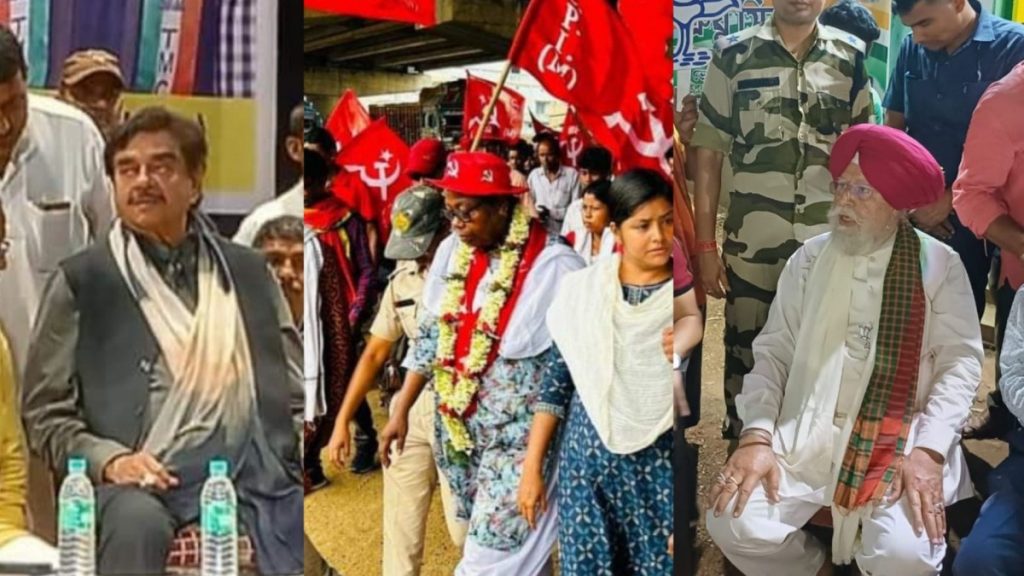For Residents in Asansol's Coal Belt, the Ground Is Constantly Giving Away
Asansol: For locals in the coal belt of Paschim Bardhaman district, neither god above, nor the governments can offer a recourse. Most name these two forces as responsible for their situation.
Open cast coal mining has become a curse for the region. Frequent land subsidence has forced people in 76 villages to flee their homes, fearing landslides.
Harishpur, Jambad, and Satgram are just a few of the 146 villages in the Asansol-Raniganj area which are identified as subsidence-prone. Despite the danger, roughly 200,000 residents remain with no proper rehabilitation plan.
Bhagirath Dutta is a resident of Harsihpur town. Once it had a population of more than 8,000 people. Now, most of the residents have abandoned it due to regular land subsidence. Cracks snake across houses, and some reduced to rubble. Meanwhile, political party murals adorn these collapsing structures.
Bhagirath blames the nearby Madhavpur mine for this predicament. "Excessive mining has hollowed out the ground beneath us," he says. "We live in constant fear. But we hardly see our local MP or MLA. With elections on, politicians now come for campaigning."
The government's proposed rehabilitation plan offers little solace. "They want us to move to Kalyanpur, another landslide prone zone. That's another disaster waiting to happen," Bhagirath says. "It's like jumping from the frying pan into the fire."

The statue outside the now defunct factory of the Chittaranjan Locomotive Works. Photo: Joydeep Sarkar
The Raniganj coalfield, the oldest coal mine in India, has been producing high-quality non-cooking coal for over two centuries. India's second-largest coal field, the Raniganj Coalfield (RCF), holds an estimated 49.17 billion tonnes of coal reserves across West Bengal and Jharkhand. However, this resource comes at a cost. Quick profit led to mushrooming of opencast mining has come at a heavy environmental cost leading to massive waste dumps, loss of vegetation and rampant soil erosion.
In 2005, the Supreme Court directed the Union government to take responsibility for the rehabilitation of the residents. In 2009, the then United Progressive Alliance government acknowledged the need for rehabilitation and approved of a master plan to help over 180,000 people affected by the region's coal mining activities. The plan allocated a budget of over Rs 2,600 crores.
The master plan assigned Eastern Coalfields Limited (ECL) the responsibility of identifying areas prone to subsidence and vulnerable populations. ECL, along with its subsidiary Bharat Coking Coal Limited (BCCL), would then handle rehabilitation efforts in those areas. The Asansol Durgapur Development Authority (ADDA) was tasked with helping those residing outside ECL and BCCL's purview.
During one of his campaign rallies in the state, Prime Minister Narendra Modi blamed the lack of support from the state government for the stalled progress of the Jhariya Raniganj Coal Project.
This is a mere chapter in the back and forth between the Modi government and the Mamata Banerjee government with the latter claiming a lack of central funding, and the Asansol Durgapur Development Authority stating it has not received funds from the centre.
However, Asansol Trinamool leader and Asansol Durgapur Development Authority chairman Tapas Bandyopadhyay said, “12,000 families are being resettled this year. Work is in progress.”
Not everyone will agree.
“The quarters meant for coal workers were grabbled by the ruing party workers. We are fighting for the affected people,” claims former MP Banghagopal Choudhury of CPI(M).

Asansol candidates from left, TMC's Shatrughan Sinha, CPI(M)'s Jahanara Khan and BJP's Surendrajeet Singh Ahluwalia.
Bordering Jharkhand district, the Asansol Lok Sabha constituency has a mixed population with coal mine workers, factory workers, members of the coal mafia, scrap dealers, a minority population and a large section of Hindi speakers.
Historically a stronghold of the Left, the seat was secured by Babul Supriyo of the BJP in both 2014 and 2019. However, following Supriyo's resignation from the BJP, Shatrughan Sinha won the seat in a by-election under the TMC banner in 2022.
Seventy-seven-year-old Sinha, vying for reelection, pledges to address local concerns in parliament. “If elected, I will raise the issue in the parliament. Didi (Mamata Banerjee) is trying to bring industries here to create employment," he said.
BJP had initially fielded Bhojpur singer Pawan Singh, who backed out following backlash for his anti-Bengali songs. He was replaced with senior party leader Surendrajeet Singh Ahluwalia, the incumbent MP from the Bardhaman-Durgapur constituency. However, Ahluwalia's late entry into the race and the defection of a significant portion of BJP workers to the TMC suggest a challenging path to victory for the 73-year-old candidate.
In the race with these two heavy weights is Jahanara Khan, the CPI(M) candidate who is focusing on door-to-door campaigning. Former two-time MLA from Jamuria, one of the assembly constituencies with the Asansol Lok Sabha seat, Khan’s strength lies in her local connection and working-class background. She has been running a Hindi medium school, 'Balbodhan Shiksha Niketan' for the past 25 years. It provides education to local children from an abandoned ECL quarter at the Dakshin Parasia mine area on the outskirts of Jamuria.
“For the situation to change, the government needs to be changed first,” emphasises Khan from the campaign trail.
Translated from the Bengali original by Aparna Bhattacharya.
This article went live on May ninth, two thousand twenty four, at zero minutes past five in the evening.The Wire is now on WhatsApp. Follow our channel for sharp analysis and opinions on the latest developments.




